Managing Disc Herniation and Alleviating Sciatica: Tips and Tricks 1
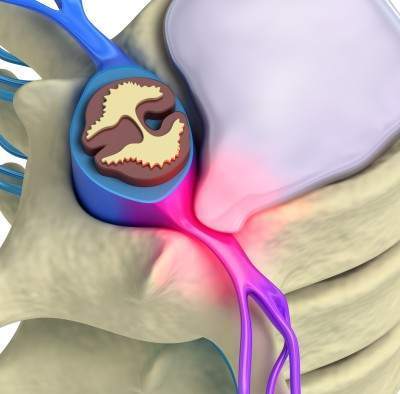
Suffering from disc herniation? Experiencing sharp pains shooting through your buttock, thigh, and leg due to sciatica? If your daily routine is disrupted by the discomfort of disc herniation, there’s hope. Many people find relief without needing surgery. This post will guide you through lifestyle changes to support your recovery from disc herniation. Stay tuned for our next piece, where we’ll explore exercises to correct and stabilize your condition.
Ultimate Guide To Exercises For Lumbar Disc Herniation Relief
Mary’s Story: A Wake-Up Call
Imagine starting your day like any other, performing your routine toe touches, when suddenly you’re hit with an excruciating pain radiating from your lower back down to your toes. This was Mary’s reality when she encountered a lumbar disc herniation, commonly referred to as a slipped or ruptured disc. Such incidents can lead to what’s known as sciatica or radiculopathy, terms doctors use to describe the pain that extends down your leg.
Understanding Lumbar Disc Herniation:
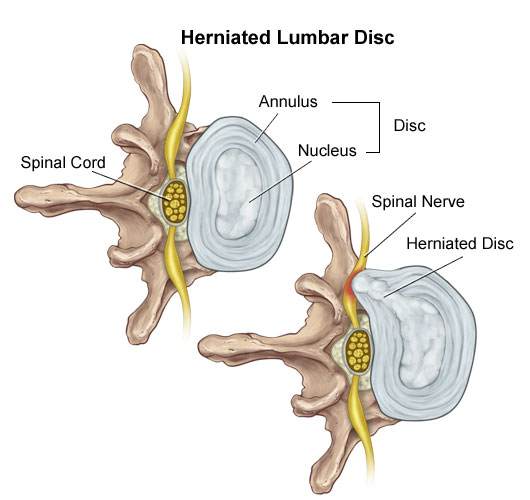
A glimpse into the anatomy of a herniated disc reveals two main components: the tough outer annulus and the softer, inner nucleus. Dr. Stuart McGill likens the nucleus to sticky phlegm. When Mary bent forward, it was akin to squeezing the front of a jelly doughnut, pushing the inner material backwards and eventually causing the disc to bulge and press on a nerve.
The Culprit Behind the Pain:
Mary’s disc herniation wasn’t a sudden mishap but the result of years of repetitive motions like toe touching and prolonged slouching at her desk. These habits gradually weakened her disc, leading to the moment when it finally herniated and impacted her nerve. The lack of nerves within the disc itself means significant damage can occur without immediate pain, explaining why the problem might not be felt until it’s severe.
A Lesson Learned:
The story underscores the importance of posture and the dangers of neglecting spinal health. While the advice to “sit up straight” might seem simplistic, maintaining the natural curve of your back is crucial. Mary’s experience serves as a potent reminder of the long-term consequences of poor posture.
Disc herniations don’t have to dictate your life. By understanding the causes and adopting preventive measures, you can manage and alleviate your symptoms.
Understanding Disc Herniation: Pain, Prevention, and Care
The Unseen Progression of Disc Herniation (see picture above)
- Bulging Disc: Early stages where the disc starts to protrude due to wear and tear.
- Prolapsed Disc: The disc bulges more as it degenerates, but the nucleus remains contained.
- Extruded Disc: The protective layers give way, pressing on nerves and causing pain.
- Sequestrated Disc: The most severe stage, where disc fragments break away, potentially compressing nerves or the spinal cord.
See Also: MRI, CT scan and X-rays: Is an MRI, CT Scan or X-ray Best For My Pain?
Why Me? The Role of Movement and Genetics in Disc Herniations
Surprisingly, your daily habits and genetic makeup play pivotal roles in disc health. While we can’t choose our genetics, modifying daily movements can significantly reduce the risk of herniation. Proper lifting techniques and posture adjustments are crucial first steps.
Simple Changes, Major Impacts: Daily Habits and Exercise
To protect your spine:
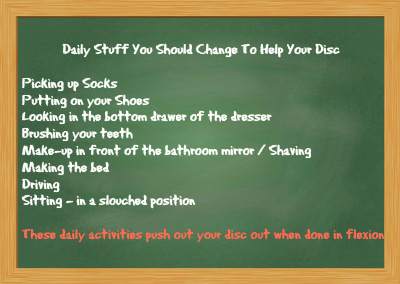
- Adjust Daily Habits: Learn to perform everyday activities in spine-friendly ways to prevent further disc damage.
- Disc-Specific Exercises: Exercises can help reposition the herniated disc.
- Stabilization Routines: Strengthening your core helps maintain spinal integrity, preventing future herniations.
Lifting Techniques: How Weight Lifters Should Lift
Master the Basic Butt-Lifting Technique for Disc Health
- Practice with a long, straight object to ensure your back remains aligned.
- Ensure it touches your butt, mid-back, and the back of your head during the entire motion.
- Squat down and maintain contact with 3 areas and keep the lower back arched the whole time.
- Aim for 30 repetitions to embed this healthy habit into your daily routine for 10 days
Daily Activity Guide: Protecting Your Discs
Then you integrate this lifting technique into everyday life. Initially, whenever you do any of these activities, use the same basic move and you will stop pushing out your disc.
In the beginning, you will need to be conscious each time you are doing any of these activities. To speed things up you can practice each activity like picking up your socks 30 times using the butt lifting technique and it will become even more automatic. You can deepen muscle memory during all of these activities.
For sitting in a chair and driving I recommend that you roll up a Mckenzie Lumbar support roll and put that in the arch of your lower back
Guide for disc herniation daily activities.
- Remember to do all these movements pain-free. Always stop whenever you run into pain with any movement of the spine.
- Disc herniations are linked with long periods of sitting, especially prolonged driving.
- Disc herniations are caused by repeated flexion.
- Prolonged trunk flexion or twisted or bend sideways cause disc herniations.
- Too much lifting, pushing/pulling causes disc herniations
- Vibration while sitting is linked to disc herniations.
- After prolonged stooping or sitting, you should stand. For example, a gardener lifting bags of peat moss after having a prolonged period of rounded lower back, or a driver getting heavy loads out of the trunk after a long drive is not recommended. You should remember to stand for a few minutes before attempting to lift. Studies have shown that ½ hour is even better.
Here are some more exercises that can cause disc herniation.
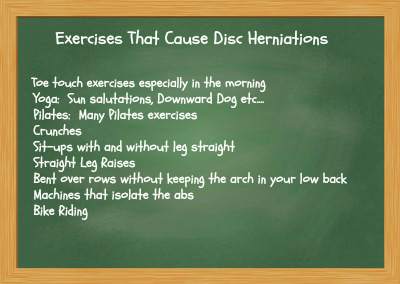
Activities That Put Out Lumbar Disc Herniations
Yes, it’s very surprising that toe touches, Yoga and certain Pilates can cause disc pressure leading to disc herniations. I have personally treated dozens of Yoga teachers with varying degrees of experience. The fact is some of the exercises involved in Yoga are great for helping disc herniations while others directly push the disc out.
Many Yoga Exercises Put Out Disc Herniations
I know many Yogis who have had to stop many of their exercises due to the pain it cause them in various parts of the body, including their disc.
Next week’s article will go over the second and third ways to help your disc. Remember, you need to do #1 “Daily Disc Activities Correctly” first so that your disc doesn’t keep getting aggravated. Then you can move on to next week’s article which goes over #2 Disc Exercises to Push the Disc Back In and #3 Stabilization Exercises help by keeping the disc from coming out by normalizing how your spine moves.
Looking Ahead: Comprehensive Care for Disc Health
Next week, we delve deeper into specific exercises for disc realignment and stabilization techniques, in this article called Ultimate Guide To Exercises For Lumbar Disc Herniation Relief. Remember, starting with correct daily activities is essential to prevent aggravating your condition further.
Tell us what you think in the comments below and like us on Facebook. This Toronto Downtown Chiropractor will answer all questions in the comments section.
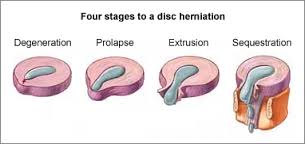
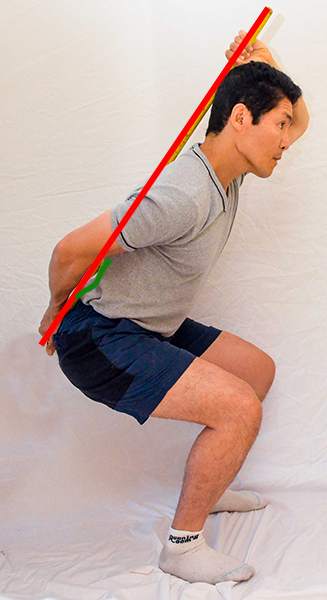


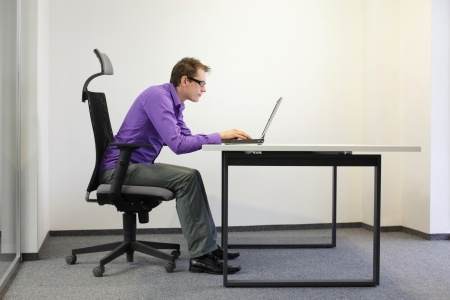

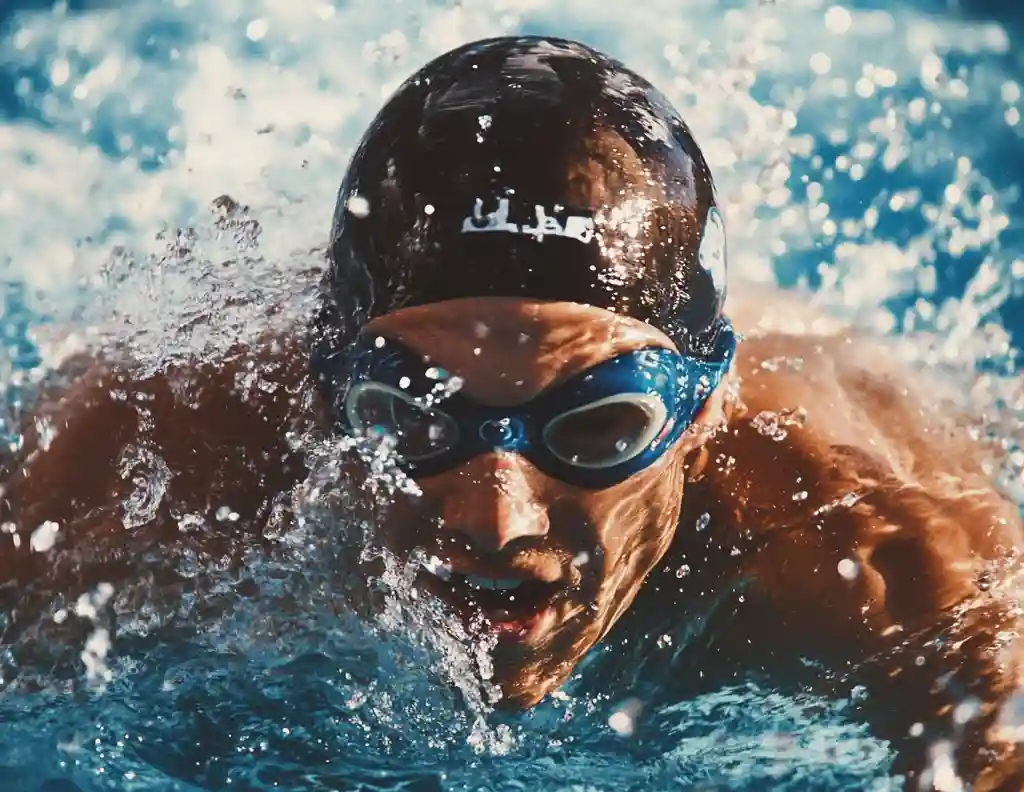

Dr. Ken, you may want to know for some reason I was unable to sign up for your newsletter and make this past from my laptop but was able to from my phone.
Anyway, just learned I have herniated disc at L2 L3. I was not shocked to learn that since I am about to turn 70 although I have been very active. However I was shocked to learn that many of the things that I was doing that I thought were keeping me in shape and limber were actually contributing to this herniation. Let’s start with once or twice a week yoga. I also golf three or four times a week and always touch my toes for a good stretch before I go out on the course. Also leading up to this diagnosis regarding my lumbar spine, I was having issues with both knees and was participating in PT. The therapist, noting the pain in my thigh and suggesting it might be coming from my back, nonetheless suggested that several times a day I touch my toes and then do it standing inverse stretch. Gosh, doesn’t anybody know what’s good for you and what’s not. So getting to my question, I really do love the entire day of yoga experience. Actually I always felt quite good after class. I have two questions, 1.. I’m wondering if I can modify the things that are no good and continue to participate in the things that are good. In your list of things that cause herniation, you listed sun salutations, downward dog, it cetera. Could you be more specific about what other yoga moves are no good. 2. As the first step in treating the herniated disc the spine doctor suggested a course of Prednisone followed up by another week of anti inflammatory to see what degree of relief I get from the that. I would like to try the Chiropractic approach. Is it reasonable to wait and see how the anti-inflammatories go or should I do that in combination. I don’t think too many medical doctors recommend DCS but I think DCs are more likely to yield to Medical doctors under certain circumstances. Sorry for the long-winded questions. Thanks so much for posting all that informative information on your website it was easy to understand and I’m sure has helped Untold numbers of people
Author
Thanks for your comment regarding the laptop and phone. First I would do exercises first before doing prednisone or anti-inflammatory. Since the problem with a disc herniation is rarely inflammation you will only get temporary or very little relief. It’s more pressure on the nerve. The exception is if the injury is very acute which it doesn’t sound like.
https://www.bodiempowerment.com/herniated-disc-part-2-the-best-exercises-for-your-herniated-disc/
Here are the exercises that may help you if you have a disc herniation that is actually the cause of your pain. I say that as a diagnosis should be based on history and exam and not the MRI or CAT scan, which is a common mistake among medical doctors, in my opinion.
For yoga you just have to know any exercises that involves flexion of the spine will have push the disc out whereas extension of the spine is generally helpful. However it depends which way your disc is coming out. For the most part that is the general rule and you sound like you have a “normal” disc.
The exercises should be supervised by someone familiar with the exercises so you don’t get worse. Yes, like any exercise you can get worse.
Hope that helps with possible disc herniation.
You are spot on with diagnosis b/c spine doctor did not examine. He looked at MRI and my complaints. No exam at all. I did do predisone pack and it gave temporary relief but pain is back. My radiology report for spine states L2-L3 mild to moderate foraminal and far lateral herniation. I also have minimal bulding at L5-S1; at L4-L5 mild to moderate OA and small 4 mm anterior spondylolisthesis and mild bilateral recess stenosis.; at L3-L4 miniimal bulding, with mild OA and ver mild lateral recess stenosis; at L1-L2 mild bulging. T12-L1 a 2mm retrolisthesis and mild bulging. INcidental is dural ectasia at the inferior aspect of the dural sac, possible congenital. Not sure if any of this changes what you said. I am now looking for a good DC.
Sir ,this is kunal . I am facing pain in left leg from the buttock to the calf end..from 1year. it take lot pain to lift my left leg upwards more above. Pain increases while standing for long time. Basic things which i did ….bike driving , had a gym and cardio exercises. Plz help me sir to get cure of this pain.
Author
Thanks for your question Kunai. I recommend you find the best chiropractor in your area. If you don’t have one try a physiotherapist. Hope that helps your possible disc herniation.
Hello sir
I have cervical disc bulge c7 as per my MRI.I got severe pain in my neck extending my shoulder for the last four weeks.l started physiotherapy, they do ultrasonic IFT everyday with neck stretching exercise. Pain is decreasing but suddenly increases due to my sitting job. What should I do to heal my disc??I want a normal pain free life.
Author
Thanks for your question Priyanka. Here are some exercises for your cervical disc herniation. https://www.bodiempowerment.com/cervical-disc-herniation-best-exercises-help-sore-neck/
However a lot of things can cause pain down into the shoulder. I would personally find the best chiropractor in your area. They can also help you with your exercises.
Hope that helps your possible cervical disc herniation.
Hi Dr.
I am 41 yrs old. 4 yrs ago I was suffering frm herniated disc. It was in left side. L5 S1. Root block was done n I got recovered.
Now after 4 years I am again suffering frm lower back pain,buttock pain n pain while sitting. MRI is done n it says tat
There is exaggeration of lumber lordosis. There is left posterolateral peripheral annular tear in t L5S1 disc without any nerve root compression
One if dr suggests endoscopy or root block again.n one dr suggests only exercises.
I am doing exercises daily as suggested.
Wht is ur advice?
Author
Thanks for your question Devi. I wouldn’t suggest surgery or nerve block. First with a nerve block you numb the nerve so you don’t feel pain but the damage is still there. With exercises you actually help the cause of the problem, provided that the diagnosis is correct.
https://www.bodiempowerment.com/herniated-disc-part-2-the-best-exercises-for-your-herniated-disc/
You should do the other exercises + these exercises if you have a posterior disc herniation. Like any exercise you can get worse. You must have the exercises supervised by a health professional that is familiar with the exercises. I would get the best chiropractor in your area. Remember that if the pain goes further down the leg than you are getting worse so you should stop the exercises immediately.
Thank u doc. I ve few queries .
Can I drive 2 wheelar as it’s necessary to drive 3 to 4 kms daily for my job. Right now I am not driving it but when could I drive it?
Should I take a walk along with exercise?
I ve a pain in my buttock while sitting n sleeping for a long period.
How much time will required to recover me in this situation? I am doing exercises 2 times s day regularly. Not taking any painkillers.
Thankx n regards
Author
Thanks for your question Devi. Provided you have a disc hernaition it is generally better to walk for shorter distances. When it gets painful you could try to do some standing extensions or sit. You should also try to interrupt your sitting posture by standing at least every 2 hours.
I cannot tell you how long it will take to recover. I don’t know your diagnosis, if you are getting treatment. Why don’t you ask the person that is treating you.
Hope that helps your disc herniation.
Hello sir
I’m suresh 30 yrs old male
I have severe back pain past 20 days .I consulted a doctor and took an MRI the report stats
Disc dessication ,loss of disc height and postero central disc extrusion L5-s1
Now the problem is that I feel numbness in my left leg penis and buttocks.
How to rectify these problems
Situation going on very bad
Sorry if my English is bad
Author
Thanks for your question Suresh. You have a yellow flag. This means that if it gets worse you may need emergency surgery. Unfortunately exercises at this point is not advised. Try to find the most comfortable position and switch between various positions. If you have trouble not being able to urininate or constipation than you should go straight to your doctor immediately for an emergency assessment.
Hope that helps your disc extrusion L5-S1.
First thank you for your hard work and for your advise. I have a l5 s1 herniation that affect my s1 nerve root the most (had an mri). I don’t feel much pain in my lower back but I feel numbness in my toes and under my toes., I need to move or I’ll get fat and it won’t be good for me. I use to bikea everyday and I was wondering if I should still cycle but without a real effort… Just start with small easy rides and do more and more as I feel better. Is there a way to cycle without agravating the herniation?
Author
Thanks for your question Pimax. It’s a good idea to keep the rides short perhaps even as short as 10 minutes to start and go longer as you get better. You should make sure to keep the lower back arched with most types of disc herniations.
Hope that helps your disc herniation.
Hi Dr. Ken,
I’m looking for some advice. Two years ago I had a true far lateral herniation that fully compressed my L4 nerve root on left hand side had significant pain that subsided relatively quickly and foot drop which eventually recovered. Have some residual numbness, on medial shin and lateral aspect of upper thigh. No surgery, conservative treatment physio combined with pilates.
For last 1.5 years I have been good with no pain. After increasing my activity, hill walking and some very slow jogging I have noticed a gradual change. I felt a weakness across my upper thigh ( no motor loss just a jelly like feeling) the numbness has increased but I have pins and needles also. The pins and needles are not constant and I can’t identity a position that antagonising them they seem to happen quite randomly bit relatively frequently. The pins and needles occur around my shin, foot, and knee though not all at same time.
The jelly feeling has gone and the numbness has settled to its original post injury state, but there is no change in the pins and needles and sometimes I feel there frequency is increasing. at present I am avoiding sitting but return to work in a couple of days which is primarily desk based.
I guess I’m wondering does this sound like a mild flare that will pass, and wondering what period of time would you suggest breaking from sitting.
Is it possible to have pins and needles from a disc compression without being able to identify the movement that increases it. My bad discs are L4/5 and 5/S1…. I do mow wonder could it be a disc higher up??
Any thoughts? Thanks for your time. I am awaiting a new mri.
Regards,
Claire
Author
Thanks for your question Claire. You are very clear, concise and very descriptive. This helps me help you better. Hill walking and slow jogging is repetitive pressure on your disc. Either one when vulnerable can make your disc come out more. The good news is it has only come out slightly. So now is the time to push the disc back in more.
You should go back to your physio and do the exercises that helps. I can’t tell with the information you are giving me what exercises to give you. You should stand up every hour.
Yes it could be a disc higher up. You need to describe where on the shin, foot and knee to tell you though. Like the outside or the inside of the knee, shin. ie more detail.
Hope that helps your disc herniation.
Sir i have l5 s1 disc show asymmetric posterior bulge intenting the cal sac L>R opposites end plate changes. Sir i am suffering from didc just by cleaning the toilet. I want to know proper exercises for this disc problem.
Author
Thanks for your question Prabha. You haven’t told me your symptoms in detail. Once you tell me with lots and lots of detail then I may be able to help.
Hope that helps your possible disc bulge.
Sir, now i have pain in my lower back, in my buttocks. I’m able to walk slowly. But sometimes feeling pain in my nerves.
Author
Thanks for your question Prabha. Why don’t you try these exercises. https://www.bodiempowerment.com/herniated-disc-part-2-the-best-exercises-for-your-herniated-disc/
If the exercises give you more pain, numbness or tingling or goes further down into your thigh then the exercises are making you worse so you would have to stop.
Hope that helps your disc herniation.
Hello sir,
My question is 2 part.
I had an L4 L5 and now its been almost a year. During this time i have put on a lot of weight and now started gyming again. My back hurts on and off but i am soldering on as i think i should reduce my weight. However i love resistant training and have started doing weights. Are there any particular exercies i should avoid? Like leg press etc.
More importantly my father also according to MRI scans has the L4 L5 disc herniation after he suffered from back pain. However although his back pain went now he has a severe pain on his left leg calf. We have tried several people in srilanka and india. Now he is learning to live with the pain. What should he do? Please do let me know if you need any further information. He cant sit in office for long and suffers on and off and i feel sorry for him.
Thank you
vivek
Author
Thanks for your question Vivek. Assuming you have a posterior disc herniation which is the most common type then you should avoid leg press, squats, bent over rows, and dead lifts for now.
As for your father if the lower back pain went into his leg then he is now worse. He may get better with these exercises. https://www.bodiempowerment.com/herniated-disc-part-2-the-best-exercises-for-your-herniated-disc/
However they are likely to make him worse without modification to the exercises by an health expert that can watch your father doing the exercises. If the pain, numbness, or tingling increases or the goes further down the leg than he is getting worse and so should stop the exercises.
Hope that helps you and your father’s possible disc herniation.
Hello Dr. Ken,
I am suffering from lower back pain from 6 months. I consulted with the physiotherapist and he gave 5 different types of exercise, and I’m regularly doing it, however, pain is increasing. Last week, I did CT scan and get the following results.
L4/5 Minimal broad based posterior disc protrusion causing mild effacement of the thecal sac, but no nerual compromise. NO central canal stenosis or foraminal stenosis.
L5/S1 disc is normal. No significant facet joint arthropathy. Incidental Posterior fusion defect at S1
L1/2, L2/3 and L3/4 discs are normal.
When I consulted with one of the GP, she was saying that i can never get rid of this one, which is making me depress. I feel itching and pain is shifting from right to left or middle part of lower back.
Your suggestion are highly regarded.
Thank you,
Dinesh Sharma
Author
Thanks for your question Dinesh. I would disagree with your doctor. First what is important is not what symptoms you feel not what’s on the CT scan. There really isn’t a lot on the CT scan. The only thing is the fusion I assume of S1 and L5. Yes you cannot change the fusion but you can certainly change the pain. You can be better if you do these exercises https://www.bodiempowerment.com/herniated-disc-part-2-the-best-exercises-for-your-herniated-disc/
However the exercises can make you worse. These exercises should be supervised by a health professional.
Hope that helps your disc protrusion.
Hi,
I have an L4 L5 disc herniation that is pressing on my spinal nerve between L4 and L5. I started to feel discomfort in November but condition was confirmed in late March by MRI. I herniated my discs years ago and doing McKenzie extension exercises helped to clear it up in 6-8 weeks. This time extension exercises cause me more pain as it further presses on my nerve creating more extreme pain. What should I be doing to release that nerve so I can fix my discs. Really at wits end after so long. Please help
Great informative article. I need to do cardio to cut down on my weight, in conjunction with exercise and good nutrition. Would working on a cross trainer have a bad impact on my herniated disc. Also I drive a lot for work, what would be the best driving position?.
Author
Thanks for your question Ronald. If you are in really acute condition then it will aggravate the problem. For most people though with a disc herniation. Going gently on a cross trainer or eliptical machine is fine as long as you are not aggressive with it.
Use a McKenzie lumbar support roll when driving.
Hope that help your disc herniation.
sir plz tell how many hours I have to sit in a day in postrolateral bludge
Author
Thanks for your question Nikhil. If you are saying that you have a disc bulge which is hurting and want to know how long is the maximum that you can sit to prevent your problem from getting worse, it’s a matter of sitting correctly not necessarily how long you sit. If you sit correctly you can sit longer. If you sit with bad posture you won’t last long at all.
Also it depends on how bad your problem is worse. In any case it’s good for everyone to get up every two hours. I you have a problem then every hour helps.
Hope that helps your possible disc bulge.
Hi Dr. K,
Thanks for all the great advice. I’m in Toronto myself, and so it’s possible you’ll see me in your office soon. I do have a physiotherapist that I’m current seeing – and I like her – but it sounds as though you may be particularly in tuned with my physical challenges.
One question for now, if I can: I’ve been reading a fair amount about the Gokhale method, which tries to suggest changes to posture to help back pain. You’re likely aware of it. Can I ask what you think? In particular, Gokhale suggests that you *not* support your lumbar, and instead support your midback. She suggests the same towel roll that you do…but specifically suggests that it be put higher, in the midback.
Can I ask your thoughts? No doubt your time is limited, but if you were able to explain why you either approve or disapprove of Gokhale’s suggestions, it’d really help me understand the body mechanisms.
Thanks,
Matt
Author
Thanks for your question Matthew. From what I already know and looking further into it I don’t see it benefiting more than the lumbar support roll. The lumbar support roll is proven through research to decrease the pressure in the disc. So far I haven’t seen any third party research which is not done by the company itself that Gokhale owns. Also the lumbar support roll is proven in real life through millions of patients and even myself finding significant benefit.
One is proven the other isn’t. Not to say it doesn’t work. It may work and be slightly or even more effective. Right now having taken 4 years of biomechanics I don’t see how it will work at this point. I may be surprised in the future.
Hope that helps your disc herniation.
hello Dr. thanks for all the wise advice.
im wondering what do you think about doing hanging abs, when you do abs hanging they will not press the disc, are they good for me having bulge discs?
thanks.
Author
Thanks for your question. Yes Daniel you are right. I recommend them all the time. If you are very acute and tender than it will aggravate the problem but if you are mostly better or completely better than hanging abs are safe.
Hope that helps your disc herniation.
Thank you for these beneficial advices. My quesion..are these exercises useful for all types of disc protrusion , even the extruded or sequestrated types ?thanks
Author
Thanks for your question Mohamed. For sequestrations most exercises including these one will likely make things worse. For extrusions the problem will likely get worse with customizing the exercises.
Hope that helps your disc herniation.
Hello Dr. Ken
Nice Article. I did some damage to my back few days ago when brushing my teeth. There was a sudden bend and a sound of ‘TAK’ in my back. I was in agonising pain. I had an X-ray done and Dr. said to rest for a week, meanwhile I also got a massage for it. Right now I am 90% pain free. I have started work from today. But there is still stiffness in my back. I am a diabetic patient. This has put a halt to many of my daily activities. Please suggest something so that I am back to my daily routine (walk, jog, etc.. Wont lift weights right now). Could this be a disk problem or a muscle spasm only. When I had extreme pain last week, it was in the back only.
Author
Thanks for your question Amit. Most likely a disc. https://www.bodiempowerment.com/herniated-disc-part-2-the-best-exercises-for-your-herniated-disc/
If the exercises cause the pain, numbness or tingling to go down into the buttock or the leg you are getting worse and you should stop immediately. These exercises should be supervised by your health care provider.
Hope that helps your disc herniation.
Thanks for all the information.
I had slip disk L5S1 seven years back confirmed by mri. I have pain in for few days when I lift heavy weight or run or do some hard work, bending. Then pain subsides in few days. The pain radiates to legs, knees and thighs. In severe cases pain is at lower back and its difficult to stand.
Please suggest some exercises to improve my condition.
Author
Thanks for your question Vishesh. First you should stop aggravating your lower back. This means stop lifting weights for now. Not even light weights. If you have a sitting job sit with the curve in your lower back. No exercises will help unless you do those two things. Then you can do the exercises here. https://www.bodiempowerment.com/herniated-disc-part-2-the-best-exercises-for-your-herniated-disc/
If the exercises increases the pain, numbness, or tingling or makes it go further down the leg than you should stop the exercises. Hope that helps your possible slipped disc.
Thank you for a VERY informative site!
I have pain, and MRI confirms L4-L5 bulge, and L5-S1 broadly-based herniated disc impinging on thecal sac.
Looking at your list of exercises that cause herniations I have a couple questions:
* I’d like to continue bike riding; is that OK, as long as I avoid “hunched-over” racing bikes?
* Are there alternatives to crunches and sit-ups that you would recommend to strenghen the abdominal muscles?
* You mention many Pilates exercises… are “planks” and side-planks an issue?
Thank you… I hope the info on your site that I’m starting to use will help my condition.
Author
Thanks for your question Jeff. Good question. You don’t tell me any of your symptoms and your MRI can really occur in a person that has absolutely no symptoms at all. Yes even 15% of 15 years have disc herniations with no symptoms at all. So hopefully your doctor didn’t diagnose you by MRI. Which means a lot of health practitioners diagnose not based on history and exam but by MRI. Often that’s wrong and MRI’s are often done as a business proposition.
So assuming that the diagnosis is correct, you should sit on your bike and any other chair with the curve in your back. Long distance bike rides and large bumps will not help your lower back. Planks are great as well as side planks.
Hope that help your possible disc herniation diagnosis.
Dr. Nakamura,
Thank you for your dedication and expertise. I have a herniated L5 and have been dealing with it for years. I was wondering if there is a way I can do Kettlebell swings even with this condition. Welcome your comments.
Jason
Author
Thanks for your question Jason. Unless your disc is quite severe you should be able to do light to medium weight kettle bell swings. Go heavy and you can aggravate your lower back. The key is keeping the arch in your lower back at all times. ie proper form. As long as keep proper form you should be fine. When you are better you should get a personal trainer to make sure your techniques is good. Keep in mind not all personal trainers are diligent enough, though most are.
Hope that helps your herniated L5S1 disc
hello sir..
my name is Inder and I did all your exercises u told me earlier n now I am so fine that I play badminton everyday, I go for running too… I am good now bt sir I have a problem… my left leg is going inward from knees, and I am so worried about it… its looking too bad when I m standing aur walking…
please help me to sort out this problem… m not happy wid my bow legs….:(
Author
You are welcome Inder. You should be happy that the exercises helped you. I would be, especially if you couldn’t play badminton or go for a run previously. You should get orthotics if your knee are going inward.
I recommend saying thank you.
Hope that helps your disc herniation.
Hi Dr Ken,
Firstly, I just wanted to thank you for all the good and wise information you have put on the website.
I have injured my lower back at work about a year ago and it was diagnosed that my L4 and L5 (specially L4) been injured and after a few physio session and rest i was fine until a few months ago when i injured myself again and after i did the MRI for the second time, the result has said that my L4 and L5 has dics bulge and its been aggravated more. i am constantly in pain and physio has not helped me yet. however i still have feeling in my legs and i can walk and do things normally but barely can bend or lift. I was wondering if there is anything i can do get over this pain and sickness as it is annoying now and i cant have my normal lifestyle now .
Best regards,
Amin
Author
Thanks for your question Amin. Assuming that diagnosis is correct you should do these exercises. https://www.bodiempowerment.com/herniated-disc-part-2-the-best-exercises-for-your-herniated-disc/
Any exercise can make you worse. If the pain, numbness or tingling goes further down the leg and increases in pain than you are getting worse and so should stop right away. These exercises should be supervised by a health professional.
Hope that helps your disc herniation.